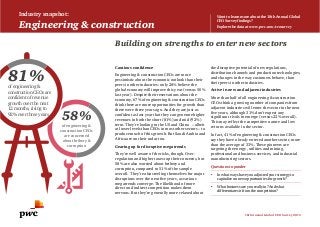
PwC - 18th Annual Global CEO Survey 2015 - Ingeniería & Construcción
- 1. Cautious confidence Engineering & construction CEOs are more pessimistic about the economic outlook than their peers in other industries: only 28% believe the global economy will improve this year (versus 50% last year). Despite their reservations about the economy, 67% of engineering & construction CEOs think there are more opportunities for growth than there were three years ago. And they are just as confident as last year that they can generate higher revenues in both the short (81%) and mid (92%) term. They’re looking to the US and China – albeit at lower levels than CEOs in most other sectors – to produce much of this growth. But Saudi Arabia and Africa are on their radar too. Gearing up for disruptive megatrends They’re well aware of the risks, though. Over- regulation and higher taxes top their concerns, but 58% are also worried about bribery and corruption, compared to 51% of the sample overall. They’re also steeling themselves for major disruptions over the next five years, as various megatrends converge. The likelihood of more direct and indirect competition makes them nervous. But they’re generally more relaxed about Industry snapshot: Engineering & construction Want to learn more about the 18th Annual Global CEO Survey findings? Explore the data at www.pwc.com/ceosurvey Building on strengths to enter new sectors Questions to ponder • In what ways have you adjusted your strategy to capitalise on new opportunities for growth? • What business are you really in? And what differentiates it from the competition? the disruptive potential of new regulations, distribution channels and production technologies, and changes in the way customers behave, than their peers in other industries. Active in new and adjacent industries More than half of all engineering & construction CEOs think a growing number of companies from adjacent industries will enter the sector in the next five years, although 31% don’t expect any significant rivals to emerge (versus 22% overall). This may reflect the competitive nature and low returns available in the sector. In fact, 41% of engineering & construction CEOs say they have already entered another sector, more than the average of 33%. These pioneers are targeting the energy, utilities and mining, professional and business services, and industrial manufacturing sectors. 18th Annual Global CEO Survey 2015 of engineering & construction CEOs are concerned about bribery & corruption 58% of engineering & construction CEOs are confident of revenue growth over the next 12 months, rising to 92% over three years 81%
- 2. Digital delivers efficiency and innovation Most engineering & construction CEOs are also investing in digital technologies to create value in new ways. Their top three priorities are cybersecurity, mobile technologies for engaging with customers and data mining and analysis. They’re also more interested in the potential of 3D printing than CEOs in most sectors; that suggests increasing levels of off-site manufacturing could become the norm. So how have these investments paid off? Engineering & construction CEOs say that digital technologies have been especially valuable in improving their company’s operational efficiency, as well as enhancing data analysis and external and internal collaboration. They are also having a positive impact on innovation capacity and sourcing and supply chain management. But maximising the returns is difficult, they warn. It requires a clear vision of how digital technologies can help to deliver competitive advantage, together with a robust plan that includes concrete measures of success and a CEO who is willing to champion digital within the enterprise. Industry snapshot: Engineering & construction Want to learn more about the 18th Annual Global CEO Survey findings? Explore the data at www.pwc.com/ceosurvey Competing in new ways to create new sources of value Get in touch with us! Jonathan Hook Global Engineering & Construction Leader +44 (20) 7804 4753 jonathan.hook@uk.pwc.com Dynamic alliances, different talent The percentage of engineering & construction CEOs who plan to form a new alliance has leapt to 61% this year, up from 49% in 2014. And they’re far more likely to be joining forces with competitors than CEOs in other sectors are (45% versus 27% overall). Half of all engineering & construction CEOs also intend to hire more people this year, but finding candidates with the right skills is a key concern. Engineering & construction CEOs have already taken several steps to address the talent shortfall: 72% have widened their search to different countries, industries or demographic segments. Similarly, 61% have implemented a strategy for promoting talent diversity. Questions to ponder • Will 3-D printing impact your business? • As the focus on alliances and working x-industry increases, have you considered who you should be partnering with? Q: Which, if any, of the following restructuring activities do you plan to initiate in the coming 12 months? Percentages of CEOs who responded with ‘Enter into a new strategic alliance or joint venture’: © 2015 PwC. All rights reserved. PwC refers to the PwC network and/or one or more of its member firms, each of which is a separate legal entity. Please see www.pwc.com/structurefor further details. This content is for general information purposes only, and should not be used as a substitute for consultation with professional advisors. 2 Base: All respondents (Engineering & construction, 2015: 114; 2014: 102) Source: PwC 17th and 18th Annual Global CEO Survey 61 49 2015 2014
